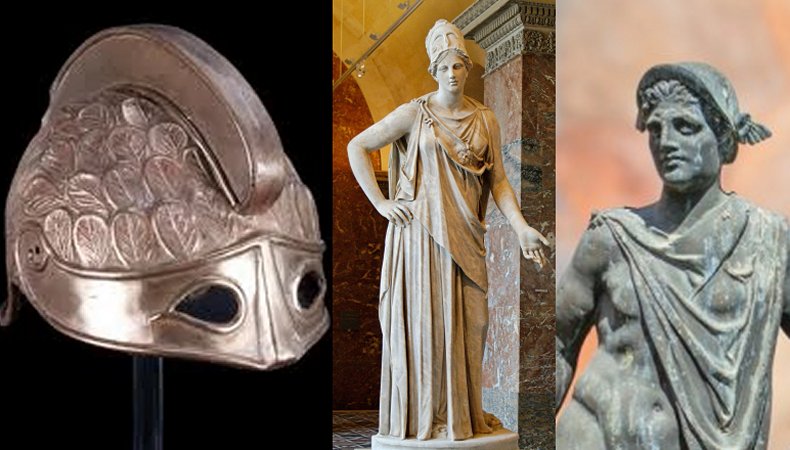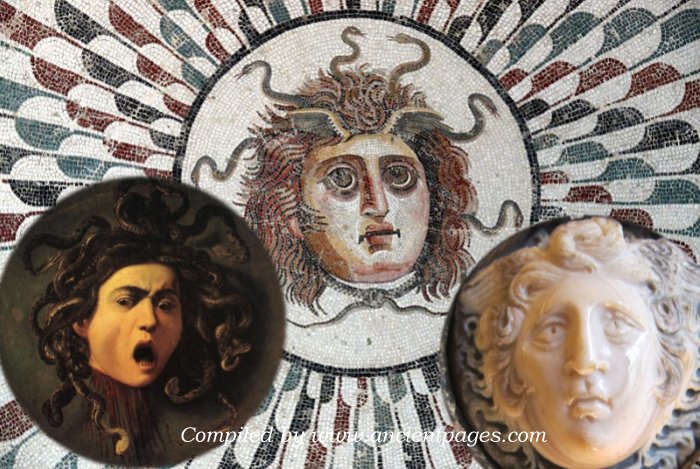Magical Cap Of Invisibility Worn By Athena, Hades, Hermes, And Perseus
Ellen Lloyd- AncientPages.com - Have you ever wanted to become invisible? You may have to wait until an invisibility cloak like Harry Potter's is available in the local store.
Meanwhile, we can always learn about ancient mythological beings who possessed the ability to become invisible at will. In ancient myths and legends, we come across several magical objects that gave a person the ability to become invisible.
Left: A helmet was worn to become invisible. Credit: Public Domain: Middle: Goddess Athena. Credit: Public Domain. Right: God Hermes. Credit: Stock Photo
One of them was the magical Ring of Gyges, which granted its owner the ability to become invisible at will.
The magical ring was perhaps a mythical object, but Gyges existed and was a historical figure, though barely anything is known about his life and reign.
The Cap Of Invisibility is mentioned in Greek mythology. It was a helmet used by the goddess Athena, the gods Hermes and Hades, and the hero Perseus whenever they wanted or needed to become invisible.
After the god Zeus liberated the Cyclops, who had been held as prisoners of Tartarus, the giants wanted to return the favor. They were undoubtedly ugly and frightening to look at, but they were skilled builders and craftsmen.
The Cyclops "went to work, beating metal on the anvil, forging for Zeus the lightning and thunderbolts of his wrath. For Poseidon, they made a huge trident, a three-pronged fork with wicked points. And for Hades, later Lord of the Underworld, they fashioned a cap of invisibility." (Michael Foss - Gods and Heroes: The Story of Greek Mythology)
Perseus Arming Himself. One of the nymphs holds out the kunea, while the others hold a winged sandal and the kibisis. Image credit: Edward Burne-Jones - 1885. Public Domain
Hades was the one who owned the Cap of Invisibility, and he used it when he fought the Titans. Hades was considered especially dangerous when he roamed the Earth wearing his helmet of invisibility.
Goddess Athena wore the Cap of Invisibility on several occasions. During the Trojan War, she had to become invisible so that Ares, the Greek god of war and one of the twelve Olympians, couldn't notice she was helping Diomedes, his enemy.
When the god Hermes was forced to fight the giant Hippolytus, whom he also killed, he wore the Cap of Invisibility.
One of the most famous mythological stories relating how practical the Cap of Invisibility was involves the hero Perseus' slaying of the Medusa monster.
Medusa's fate was sealed once Athena cursed her. As Ancient Pages wrote earlier, Perseus sought Medusa out to defeat her once and for all.
Perseus used the Cap of Invisibility to kill Medusa.
What was tragic for Medusa was that Perseus had some help from the gods. He was given special weapons to defeat her and escape her monstrous siblings. Athena gave Perseus the Cap of Invisibility. Wearing the magical helmet, Perseus could avoid the gorgon's deadly gaze and successfully escape from the immortal monsters Stheno and Euryale after he had decapitated Medusa.
The Cap of Invisibility offered complete protection, and its wearer could hide even from the eyes of supernatural beings.
This fantastic magical object is also known as the Cap of Hades, Helm of Hades, or Helm of Darkness. The ability to become invisible was mentioned in many myths and legends.
In Welsh mythology, we encounter a "Mantle of Invisibility" in the story of Culhwch and Olwen. In German mythology, a dwarf king is the owner of the Tarnkappe, enabling him to become invisible at will. Sometimes, it is said that gods possessed supernatural powers that gave them the ability to vanish into thin air. On other occasions, they used particular objects like the Cap of Invisibility so that no one could see them.
Updated on March 14, 2024
Written by Ellen Lloyd – AncientPages.com
Copyright © AncientPages.com All rights reserved. This material may not be published, broadcast, rewritten or redistributed in whole or part without the express written permission of AncientPages.com
More From Ancient Pages
-
 You Can Visit The Tomb Of Jesus – 3D Virtual Tour Opens Soon
Archaeology | Nov 10, 2017
You Can Visit The Tomb Of Jesus – 3D Virtual Tour Opens Soon
Archaeology | Nov 10, 2017 -
 Star-Shaped Magnetic Anomaly At Hidden Stone Circle In The Outer Hebrides Gives New Insight Into Ancient Beliefs
Archaeology | Jan 2, 2020
Star-Shaped Magnetic Anomaly At Hidden Stone Circle In The Outer Hebrides Gives New Insight Into Ancient Beliefs
Archaeology | Jan 2, 2020 -
 Keeladi, India: Ancient Residents Along Vaigai River Had Adopted Highly Progressive Technologies
Archaeology | Aug 28, 2020
Keeladi, India: Ancient Residents Along Vaigai River Had Adopted Highly Progressive Technologies
Archaeology | Aug 28, 2020 -
 Sacred Number Six And Its Symbolic Significance In Ancient Cultures
Ancient Symbols | Dec 27, 2017
Sacred Number Six And Its Symbolic Significance In Ancient Cultures
Ancient Symbols | Dec 27, 2017 -
 Archaeologists Shed Light On The Lives Of Stone Age Hunter-Gatherers In Britain
Archaeology | Jan 20, 2023
Archaeologists Shed Light On The Lives Of Stone Age Hunter-Gatherers In Britain
Archaeology | Jan 20, 2023 -
 Why Was The Iron Age Village Near Elgin In Scotland Suddenly Abandoned And Burned Down?
Archaeology | Jul 29, 2022
Why Was The Iron Age Village Near Elgin In Scotland Suddenly Abandoned And Burned Down?
Archaeology | Jul 29, 2022 -
 Unique Geoglyphs In Torgay, Kazakhstan – Destroyed
Civilizations | Sep 5, 2015
Unique Geoglyphs In Torgay, Kazakhstan – Destroyed
Civilizations | Sep 5, 2015 -
 Unexpected Discovery Of Huge Iron Age Roundhouse At Dinas Dinlle, Wales
Archaeology | Sep 9, 2019
Unexpected Discovery Of Huge Iron Age Roundhouse At Dinas Dinlle, Wales
Archaeology | Sep 9, 2019 -
 Ruins Of Roman Temple From Reign Of Emperor Antonius Pius Unearthed In Egypt
Archaeology | May 15, 2018
Ruins Of Roman Temple From Reign Of Emperor Antonius Pius Unearthed In Egypt
Archaeology | May 15, 2018 -
 Nakanishi Ruins: One Of Japan’s Largest Ruins Discovered In Nara
Civilizations | Aug 22, 2015
Nakanishi Ruins: One Of Japan’s Largest Ruins Discovered In Nara
Civilizations | Aug 22, 2015 -
 New Details On Neanderthals – Revealed By Museum Exhibition In Norway
Archaeology | Jun 16, 2023
New Details On Neanderthals – Revealed By Museum Exhibition In Norway
Archaeology | Jun 16, 2023 -
 Why Did Ancient Egyptians Use Pillows Made Of Stone?
Ancient History Facts | Jun 18, 2018
Why Did Ancient Egyptians Use Pillows Made Of Stone?
Ancient History Facts | Jun 18, 2018 -
 Darabgerd: One Of The Oldest Cities Dated To Achaemenid Era
Featured Stories | Jan 28, 2021
Darabgerd: One Of The Oldest Cities Dated To Achaemenid Era
Featured Stories | Jan 28, 2021 -
 Mystery Of The Brave Viking Chief Buried On The Gokstad Ship
Featured Stories | Mar 14, 2016
Mystery Of The Brave Viking Chief Buried On The Gokstad Ship
Featured Stories | Mar 14, 2016 -
 Spartacus: The Rise And Fall Of An Unlikely Hero
Featured Stories | Oct 4, 2022
Spartacus: The Rise And Fall Of An Unlikely Hero
Featured Stories | Oct 4, 2022 -
 Zeus – ‘Cloud Collector’, God Of Order, Law And Justice – Most Powerful God Of Olympian Pantheon
Featured Stories | Jan 3, 2019
Zeus – ‘Cloud Collector’, God Of Order, Law And Justice – Most Powerful God Of Olympian Pantheon
Featured Stories | Jan 3, 2019 -
 Controversial Study Of Ancient DNA Could Re-Write History Of South Florida And Prove Humans And Huge Prehistoric Animals Co-Existed
Archaeology | Sep 23, 2014
Controversial Study Of Ancient DNA Could Re-Write History Of South Florida And Prove Humans And Huge Prehistoric Animals Co-Existed
Archaeology | Sep 23, 2014 -
 Puzzling Palpa Lines In Peru Made By The Paracas Culture Are Even Older Than The Nazca Lines
Featured Stories | Jan 2, 2018
Puzzling Palpa Lines In Peru Made By The Paracas Culture Are Even Older Than The Nazca Lines
Featured Stories | Jan 2, 2018 -
 170-Million-Year-Old Sea Monster Identified As The Oldest Mega-Predatory Pliosaur
Evolution | Oct 23, 2023
170-Million-Year-Old Sea Monster Identified As The Oldest Mega-Predatory Pliosaur
Evolution | Oct 23, 2023 -
 Danish Royal Sunken Ship Sheds Light On Psychological Warfare In The Middle Ages
Archaeology | Apr 3, 2017
Danish Royal Sunken Ship Sheds Light On Psychological Warfare In The Middle Ages
Archaeology | Apr 3, 2017



